The objective of this paper was to evaluate yield of performance and economic aspects of ten clones of rubber tree [Hevea brasiliensis (Willd. ex. Adr. de Juss.) Muell. Arg.] in different frequencies of tapping and with stimulation with ethefon. The trial was placed at the Indiana farm, in the county of Indiana, SP, Brazil, under a split-plot design. The main treatments were the GT 1, RRIM 701, RRIM 600, PB 235, PR 261, PB 252, Fx 4098, Fx 2261, Fx 3864 and IAN 873 clones submitted to three systems of tapping 1/2S d/2 6d/7 (check), 1/2S d/4 6d/7.10m/y. ET 5.0% Ba 10y and 1/2S d/6 6d/7.10m/y. ET 5.0% Ba 10y. The variables were: girth increment, yield, panel desiccation and economic aspects. Results indicated superiority in the 1/2S d/2 6d/7 system in most of the clones, except for GT 1 and PB 235 clones, that in the 1/2S d/4 ET 5.0% system showed superiority of net gain of 12.0% and 54.0%, respectively, compared with the check tapping system. Only the Fx 3864 and PB 235 clones showed liquid gain of 18.0% and 28.0%, respectively, in the 1/2S d/6 ET 5.0% system, compared with the check. The highest incidence of panel desiccation was observed in the PB 235 clone in the 1/2S d/4 ET 5.0% system.
Hevea; latex; rubber; brown bast; economic analysis







